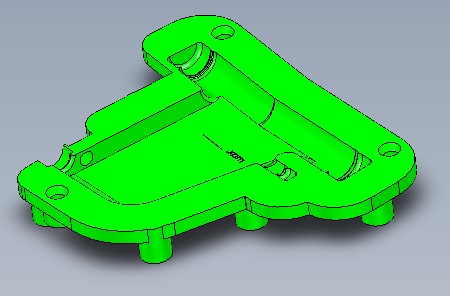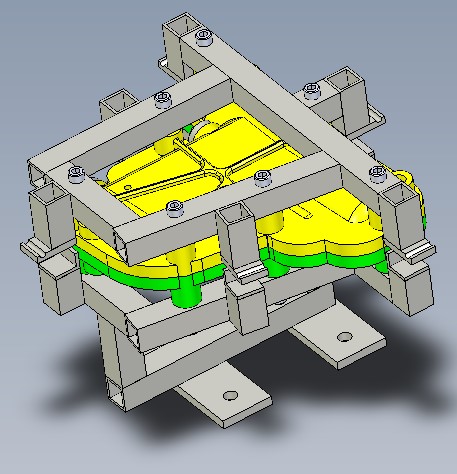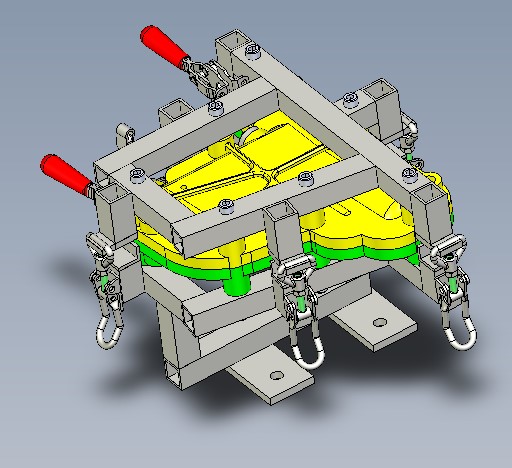Elements of a Rotary Mould
We are your partner when it comes to the production of high-quality tools and accompany you from the design through the engineering to the mould making. During the process, we support you through the complete project phase and react quickly and flexibly to your change requests.
![]() Precise plastic articles require high-quality tools. The spectrum of our mould construction covers all processes, from the development of plastic mouldings through the tool design, supported by simulation techniques and prototype manufacturing up to the construction of serial tools. Additionally, we only use high-quality aluminum moulds and steel sheet moulds in our production.
Precise plastic articles require high-quality tools. The spectrum of our mould construction covers all processes, from the development of plastic mouldings through the tool design, supported by simulation techniques and prototype manufacturing up to the construction of serial tools. Additionally, we only use high-quality aluminum moulds and steel sheet moulds in our production.
During mould making, we find the best solution for your applications. We deal with any geometry, no matter how complicated it is. We would be pleased to show you our experience, reliability and our innovative spirit.

The maintenance and care taking of our moulds is our top priority. Maintenance, adaptations or repairs are carried out by our experienced staff in regular checks with the utmost precision and care.
We will be happy to meet you and are looking forward to your request.
The mold trays

The main component of a rotary mould are the two mould trays. Plastic powder is filled into these, to adhere and melt on the inside of the mould during the process. The precise processing on modern CNC milling enables to remove non necessary and heat-blocking aluminum as far as possible, to produce a homogeneous mould tray. This reduces the inserted energy to enable an evenly melting of the raw material. In contrast to moulds made from cast aluminum, the use of rolled aluminum has the advantage of being free from blowholes and pores, which improves a homogeneous heat distribution in the mould. Moulds made of aluminum are produced with a wall thickness of 8-10mm, whereby the flanges are produced a little thicker. Mould made out of steel sheet are produced with a wall thickness of 3-4mm. Since the tolerances are significantly higher with the case of steel sheet metal tools through the manual processing and the optical quality of the surface doesn’t touch the CNC-milled moulds, these moulds are often used for larger industrial parts.
During the construction of the rotary mould, all details are modeled in 3D in advance. Thus, mould reinforcements and anchor points can be directly milled. This prevents the straining of the material through subsequently welding and minimizes the risk of a default in the tool.
Finishing of the mould trays

After the mechanical processing of the mould trays, the desired refinement can be carried out. On request, we offer the possibility of flange hardening.
Because of the frequently opening and closing of the mould, as well as the cleaning of the flange surfaces, mechanical loads occur which influence the mould separation. This can lead to a widening of the visible separating surfaces. The hardening of the flange surfaces of the rotary mould reduces this what leads to a longer tool life.
The inner surface of the rotary tool can be sealed with a Nano Paint. This has the advantage that no semi-permanent release agent has to be used. We thus produce a permanent coating of the tool and therefore a constant surface quality for the final product.
Attachment- and lot parts of a rotary mould

Through the use of different materials in the mould construction, different thermal conductivities of the mould and lot parts can be used to influence the subsequent wall thicknesses of the moulded part. For example, brass inserts lead the heat into the insert in a better way and ensure a good remelt with the plastic material. The use of hardened steel wear tubes ensures a long service life of the tools. All drawings and 3D models of the rotary tool and its attachments are saved with us. Thus, wear parts such as brass pins can always be reordered.
The frame

The steel frame is used to receive the rotary form on the rotary unit and to stabilize the rotary form. Here, we particular value the light construction which produces a very low heat deflection but still provides a sufficient stability in the mould trays to support the aluminum.

The two frames are then held together with different tensioners, in order to keep the mould completely closed during the process. Bolts are holding the lot parts of the mould in position and ensure a precise positioning inside the tool.

